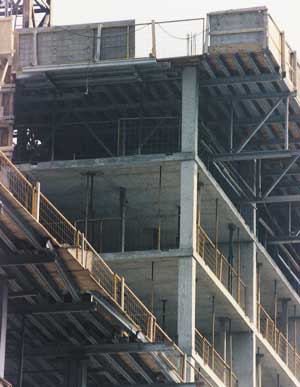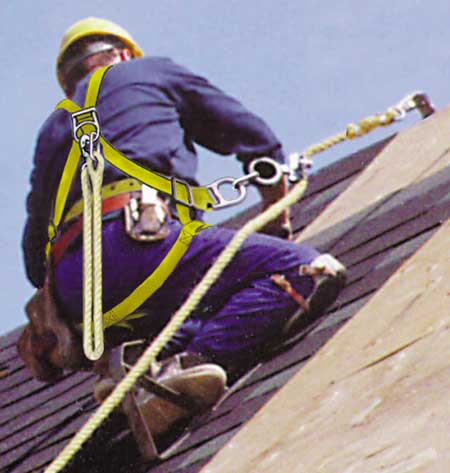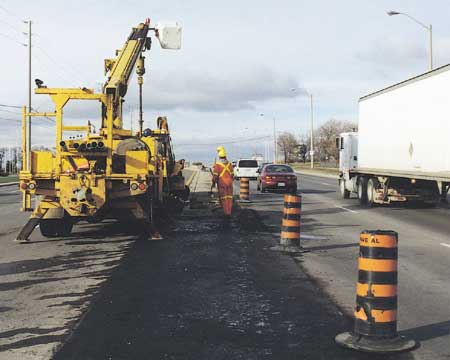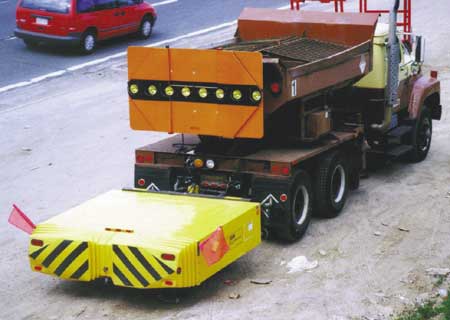Summary Statement
Description of new Canadian regulation that deals with fall protection, traffic control and toilet clean-up.
summer 2000
See
: Occupational Health and Safety Act and Regulations for Construction
Projects
Ontario Regulation 213/91, the "Construction Regulation," has
been amended by Ontario Regulation 145/00 filed in March 2000. The amended
regulation came into effect on 12 June 2000. Major changes involve fall
protection, traffic control, and toilet and cleanup facilities. For more
information, refer to the appropriate sections on the following pages.
Other points in the new regulation are outlined below.
This article is provided as a summary only. For details, refer to the Occupational Health and Safety Act and Regulations for Construction Projects, June 2000 edition. Copies are available from Publications Ontario (416-326-5300) and CSAO (1-800-781-2726). For a side-by-side comparison of the old regulation and the new, visit http://www.mdrao.ca/.
What's new?
- definitions
- administrative
requirements for registration and project notification
- minimum age requirement
for workers
- requirement that
a constructor establish emergency procedures
- new Section 26
covering fall protection (guardrails, formerly in Sections 85 and 86,
are now included in this section)
- new Section 29
on toilet and wash-up facilities
- new Sections 67-69
on traffic control
- revisions regarding
general equipment (Sections 93-116)
- editorial changes throughout.
Registration and
Notification (Sections 5-6)
- Before beginning
work at a project, each constructor and employer engaged in construction
must complete an approved registration form from the Ministry of Labor
(MOL). The constructor must ensure that each employer at a project provides
the constructor with a completed registration form. These forms must
be kept at the project for as long as the employer is working there.
- The constructor
must complete an approved notification form and file it at the MOL office
nearest to the project.
- Where the project will take no longer than 14 days to complete, notification forms may be faxed to the MOL.
Supervisor (Sections
14-15)
In addition to the requirement for an employer of five or more workers
on a project to appoint a supervisor for the workers, the supervisor must
supervise the work at all times either personally or by having an assistant,
who is a competent person, do so personally.
Minimum Age (Section
16)
People employed in or about a construction project or permitted to be
present in or about the project while work is being performed must be
at least 16 years of age.
Emergency Procedures
(Section 17)
- On a project the
constructor must establish written procedures to be followed in an emergency.
The procedures must be reviewed with the joint health and safety committee
or the health and safety representative on the project.
- The constructor
must ensure that the emergency procedures are posted in a conspicuous
place at the project.
- The constructor must ensure that every worker at a project has access to a telephone or other system of two-way communication in the event of an emergency.

Other
Highlights
- A worker using
a chainsaw must be trained in its use and wear specific personal protective
equipment while operating the saw.
- Workers who may
be required to use a fire extinguisher must be instructed in its use.
- A worker who operates an explosive-actuated fastening tool must be trained in its use. While using the tool, the worker must carry proof of training and wear adequate personal protective equipment, including adequate eye protection.
Fall Protection
Definitions
New definitions in Section 1 identify the major aspects of fall protection.
Fall restricting system a type of fall arrest system that has been designed to limit a worker's fall to a specified distance.
Fixed support a permanent or temporary structure, or a component of such a structure, that can withstand all loads and forces the structure or component is intended to support or resist, is sufficient to protect a worker's health and safety, and includes equipment or devices that are securely fastened to the structure or component.
Guardrail system an assembly of components joined together to provide a barrier to prevent a worker from falling from the edge of a surface.
Safety net a safety net that complies with Section 26 and is located and supported in such a way that it arrests the fall of a worker who may fall into it without endangering the worker.
Travel restraint system an assembly of components capable of restricting a worker's movement on a work surface and preventing the worker from reaching a location from which the worker could fall.
General
Requirements for fall protection are set out in Section 26. Workers must
be protected from falling by use of at least one of the following methods:
-
- guardrails
- protective coverings
- a travel restraint system
- a fall restricting system
- a fall arrest system
- a safety net.
- Components of
a travel restraint, fall restricting, or fall arrest system must meet
requirements of applicable CAN/CSA standards.
- Before using fall arrest or safety net systems on a project, employers must develop written procedures for rescuing workers in case of a fall arrest
- Workers who may
use a fall protection system must be adequately trained in its use and
given adequate oral and written instructions by a competent person.
- Records of training
must include workers' names and dates of instruction and be available
to an MOL inspector on request.
- Requirements for training come into force on 12 June 2002.
Guardrails
Requirements for guardrails are now included in Section 26 rather than
in Sections 85-86.
Regardless of the materials used, guardrails must meet the following specifications.
- A guardrail system
at the perimeter of a work surface must not be more than 300 mm from
the edge.
- Toe boards must
be at least 100 mm high or, if made of wood, at least 89 mm high.
- The intermediate
rail may be replaced by material that can withstand a point load of
450 newtons applied in a lateral or vertical downward direction.
- Anywhere along
its length, a guardrail system must be capable of resisting, without
exceeding the allowable unit stress of its component material, the following
loads when applied separately:
- a point load
of 675 newtons applied in a lateral direction to the top rail
- a point load
of 450 newtons applied in a vertical downward direction to the top
rail
- a point load
of 450 newtons applied in a lateral or vertical downward direction
to the intermediate rail, or midway between top rail and toe board
- a point load of 225 newtons in a lateral direction to the toe board.
- a point load
of 675 newtons applied in a lateral direction to the top rail
- When any two adjacent posts of a guardrail system are more than 2.4 meters apart, the system must be capable of resisting the point loads specified above increased in proportion to the greater distance between the posts.

Wood slat guardrails are no longer specified in the regulation. Their use may be established under Section 3, Alternative Methods and Materials.
New requirements for wood guardrails specify that
- wood be spruce,
pine, or fir (SPF) timber of construction grade or better
- the top and intermediate
rail be at least 38mm by 89mm (changed from 19mm x 89mm)
- posts be a minimum of 38mm x 89mm and spaced at intervals of not more than 2.4 meters
- the outward deflection
of the top and intermediate rails resulting from the point loads specified
not extend beyond the edge of a work surface
- the system have vertical separators at intervals of not more than 2.4 meters and horizontal supports at intervals of not more than 9 meters
Travel Restraint
System
This system may involve a full body harness or safety belt. System supports
must be capable of supporting a static force of at least 2 kilonewtons
without exceeding allowable unit stress for each material used.

Fall
Restricting System
The system must be arranged in accordance with manufacturer's instructions
so that a worker's free fall does not exceed 0.6 meters The support used
in the system must be capable of supporting a static force of at least
6 kilonewtons without exceeding the allowable unit stress for each material
used. A fall restricting system must be used when work on utility poles
cannot practically be done from an elevating work platform.
Fall Arrest System
A fall arrest system requires a full body harness and lanyard equipped
with a shock absorber unless use of the shock absorber will cause the
worker to hit anything below the work, whether object, ground, or other
surface. System support must be capable of supporting a static force of
at least 8 kilonewtons, or 6 kilonewtons when a shock absorber is used,
without exceeding the allowable unit stress for each material used.
Inspection and
Testing
Travel restraint, fall restricting, and fall arrest systems must be inspected
by a competent worker before each use and taken out of service if a defect
is detected or the system is subjected to a fall. Following a fall, the
system must not be used again unless all of the components are certified
by the manufacturer as being safe for reuse.
Support capacity of a temporary fixed support may be determined by dynamic testing to ensure the fixed support is adequate to arrest a worker's fall.
Safety Nets
Safety nets must be designed, tested, and installed in accordance with
ANSI Standard 10.11-1989, Personnel and Debris Nets for Construction
and Demolition. A copy of engineering documents for testing and inspection
must be kept at the project while the net is in service.
Horizontal Lifelines
Horizontal lifelines must be designed by a professional engineer. The
design may be standardized for application on various projects. Design
drawings must show the arrangement of the system including anchorage,
components used, number of workers allowed to use it, instructions for
installation, and design loads. Design drawings must be kept on the project
as long as the system is used. The system must be inspected before each
use by a competent worker or a professional engineer.
Traffic Control
Definitions
barricade device providing visual indicator of path for motorists, such as traffic drums or cones
barrier a physical barrier through which vehicles would not normally pass, i.e., concrete barrier
blocker truck a truck weighing at least 6,800 kg with four-way flashers and a mounted flashing arrowboard sign
crash truck a blocker truck equipped with a crash-attenuating device
freeway a controlled-access highway with a continuous dividing median and a normal posted speed of 90 km/h or more
highway any common public road, highway, street, etc. intended for or used by the general public for passage of vehicles
longitudinal buffer area (LBA) zone between the end of a lane closure taper and the start of a work area (intended to give errant vehicles intruding on the work zone a chance to stop)
roadway traveled portion of highway
sign truck vehicle equipped with flashing arrowboard and 4-way flashers or portable trailer with flashing arrowboard.

New
Requirements (Sections 67-69)
- Certain measures
to protect workers are now mandatory, including blocker, crash, and
sign trucks.
- An employer on
a roadway project must develop a traffic protection plan.
- Workers directly
involved in setting up and removing a traffic control system on a roadway
must be "competent."
- Adequate barrier
walls are required on stationary freeway projects lasting five days
or more.
- LBA and buffer
vehicles are required on freeway projects lasting less than five days
or where the use of barriers is not practical.
- Starting 1 January
2003, crash trucks must replace blocker trucks in traffic control systems
on freeways or where the use of barriers is not practical.
- The use of a traffic
control person (TCP) is limited to roadways with posted speeds of 90
km/h or less.
- A new octagonal
shape and new reflective material will be required for the TCP sign,
effective 1 January 2001.

Protective
Clothing
- Minimum requirements
for garments worn by workers are specified -- blaze orange vest with
fluorescent yellow stripes 50mm wide, two on front and two on back.
The yellow area must be at least 500cm squared on the front and 570cm
squared on the back. The two stripes on the front must be arranged vertically;
those on the back, in an X pattern.
- Nylon vests must
have a side and front tearaway feature, effective 1 January 2001.
- For enhanced night visibility, workers must wear retroreflective silver stripes encircling each arm and leg or equivalent side visibility-enhancing stripes with a minimum area of 50cm squared (clarification forthcoming).
Equipment Backing
Up
New measures for on-site traffic control are intended to prevent death
and injury from vehicles backing up.
- Projects must
be planned to eliminate or minimize the need for equipment to operate
in reverse.
- Where equipment
must back up on site, signs must be posted to warn workers of the hazard.
- Dump trucks must
be equipped with audible alarms that signal when the trucks are operated
in reverse.
- Signallers directing on-site traffic must wear the same retroreflective fluorescent garment as TCPs.
Facilities
Section 29 deals exclusively with "facilities." This term refers to toilet, urinal, and cleanup facilities. Toilets may be "sewered" or "non-sewered."
Sewered toilets are flush toilets connected to a sanitary sewer system. Non-sewered toilets are not connected to a sanitary sewer system and are flushed with water containing chemical additives.
Facilities must be located within 180 meters horizontally of the project and, in construction of buildings, within 9 meters vertically of the level at which work is being done.
The constructor must post the location of toilet and cleanup facilities, service the facilities as necessary to keep them clean and sanitary, and maintain records of servicing performed.
Facilities must be equipped with a toilet paper holder, sufficient supply of toilet paper, adequate illumination, adequate ventilation, a self-closing door that can be locked from inside, and protection from weather and falling objects.
Separate facilities must be provided for male and female workers, unless the facilities are to be used by only one worker at a time. Separate facilities must be clearly identified by signs. Facilities intended for use by female workers must include a disposal receptacle for sanitary napkins.
The number of sewered toilets required depends on the number of workers on site.
| Minimum number of sewered toilets | Workers regularly employed on project |
|
1
|
1-15
|
|
2
|
16-30
|
|
3
|
31-45
|
|
4
|
46-60
|
|
4,
plus 1 additional toilet for each group of 15 or fewer workers
|
61
or more
|
The regulation also includes provisions covering non-sewered toilets and substitution of urinals for toilets.
Cleanup facilities must have
-
- a wash basin with
running water if reasonably possible; otherwise waterless hand cleanser
- soap or hand cleanser
- paper towels or a hand dryer
- receptacle for used paper towels.
Information
in this article is provided as a summary only.
For accurate and complete reference, consult the
Occupational Health and Safety Act and Regulations for Construction
Projects (issue date: June 2000).


